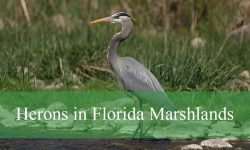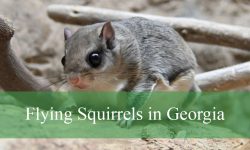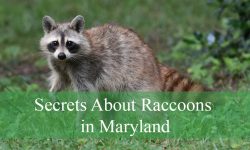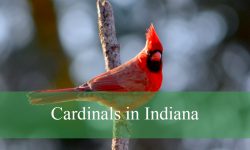Texas is home to 37 different sparrow species. These small birds live in a variety of habitats across the state, from cities and farms to deserts and wetlands. Some sparrows stay year-round while others visit during migration seasons. Although many look alike, each species has unique features that help with identification.
Sparrows can be difficult to tell apart because of their similar sizes and colors. This guide provides clear descriptions and photos to make spotting and identifying sparrows easier and more enjoyable. Understanding their habits and appearances can help you appreciate these birds more.
This article covers all the sparrows found in Texas, focusing on their size, plumage, songs, and preferred habitats. It is designed to help both beginners and experienced birdwatchers improve their ability to recognize these fascinating birds.
Common Sparrows Found in Texas
House Sparrow (Passer domesticus)
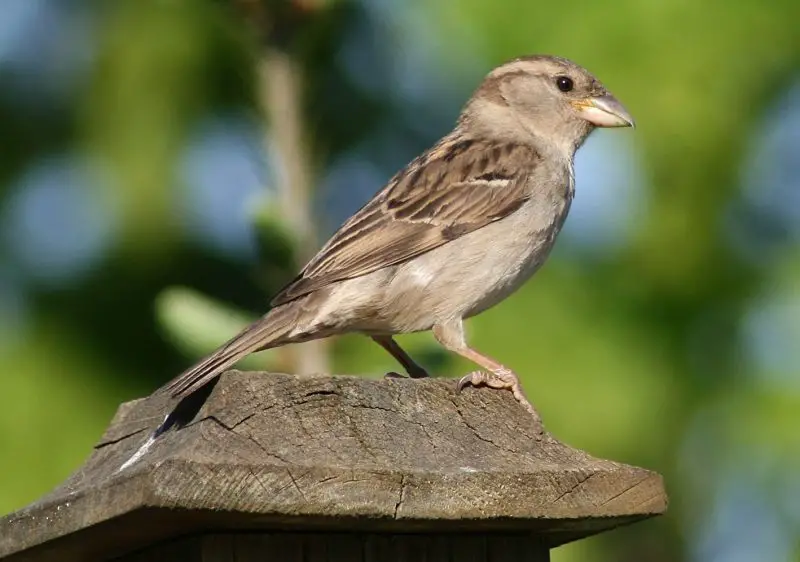
The House Sparrow is a non-native species in North America but has become one of the most widespread and recognizable birds in Texas. It features a stout body with grayish underparts, a chestnut nape, and black streaks on the back. Males are easy to identify with their gray crown, black bib, and white cheeks, while females are more plain, with a buffy-brown overall tone and pale eyebrow. Their compact size averages around 6.3 inches in length with a wingspan of about 9.8 inches.
House Sparrows are extremely adaptable and commonly found in urban and suburban areas throughout Texas year-round. They thrive around human settlements, including city parks, farms, residential neighborhoods, and shopping centers. These sparrows are social birds, often gathering in noisy flocks and aggressively competing for nesting sites, especially around buildings and streetlights.
Though they don’t migrate, House Sparrows may shift locally in response to food availability. Their diet includes seeds, grains, and scraps from human food. They nest in cavities or any sheltered area they can find and are known for displacing native bird species. Despite their invasive status, they remain a staple of the urban birdscape across the state.
Song Sparrow (Melospiza melodia)
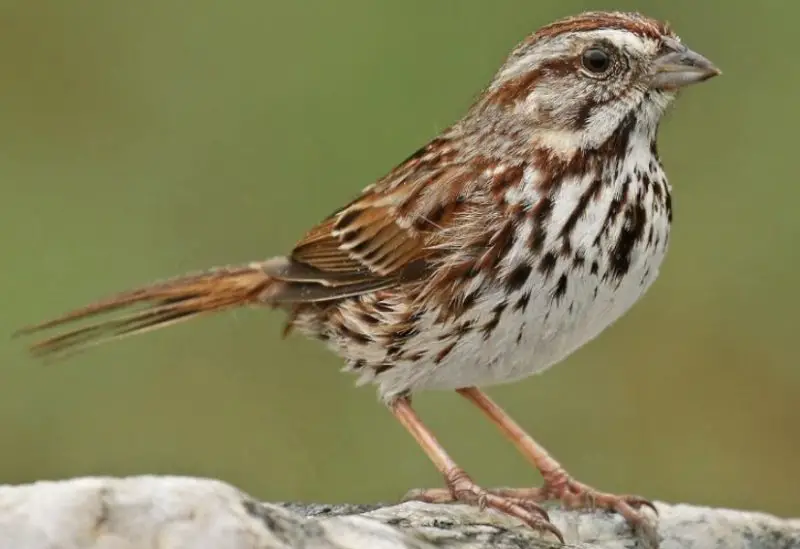
The Song Sparrow is a medium-sized sparrow known for its melodious and varied song. It has brown streaking across its white chest that often converges into a central dark spot. Its back is also streaked brown, and its face displays a grayish tone with a brown eye stripe. This bird is about 5.9 inches long with a wingspan of 7.1 to 7.9 inches, giving it a compact but sturdy look.
In Texas, Song Sparrows are primarily found during the winter and migration periods. They inhabit a wide range of habitats such as marsh edges, open woodlands, brushy fields, and suburban gardens. These sparrows often stay low in dense vegetation, flicking their tails and giving off sharp chip notes when disturbed.
Their behavior is somewhat secretive, but males will perch conspicuously during the breeding season in other regions to sing their complex tunes. While Texas doesn’t host breeding populations, many birds winter here and use it as a stopover during migration, especially in the central and eastern parts of the state.
Savannah Sparrow (Passerculus sandwichensis)
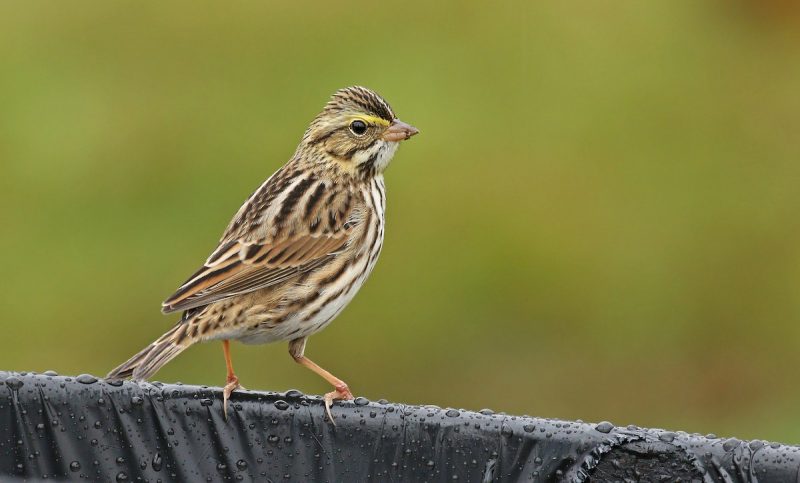
Savannah Sparrows are small, streaky brown sparrows with a distinctive yellowish patch in front of the eye and a short, notched tail. Their finely streaked breast and crown can make them resemble other sparrows, but that subtle yellow above the eye is a helpful field mark. They measure about 5.1 to 5.9 inches in length, with a wingspan between 7.9 and 8.7 inches.
These sparrows are widespread in Texas during the winter months, especially in open habitats like grasslands, prairies, coastal areas, and agricultural fields. They often forage on the ground, walking or hopping through low vegetation in search of seeds and insects. When flushed, they tend to fly a short distance before dropping back into cover.
Despite their inconspicuous nature, Savannah Sparrows can be quite numerous in the right habitats. Some may sing even in winter, especially during mild periods. Their adaptability to both coastal and inland environments helps them remain one of the most frequently observed wintering sparrows in Texas.
Lincoln’s Sparrow (Melospiza lincolnii)
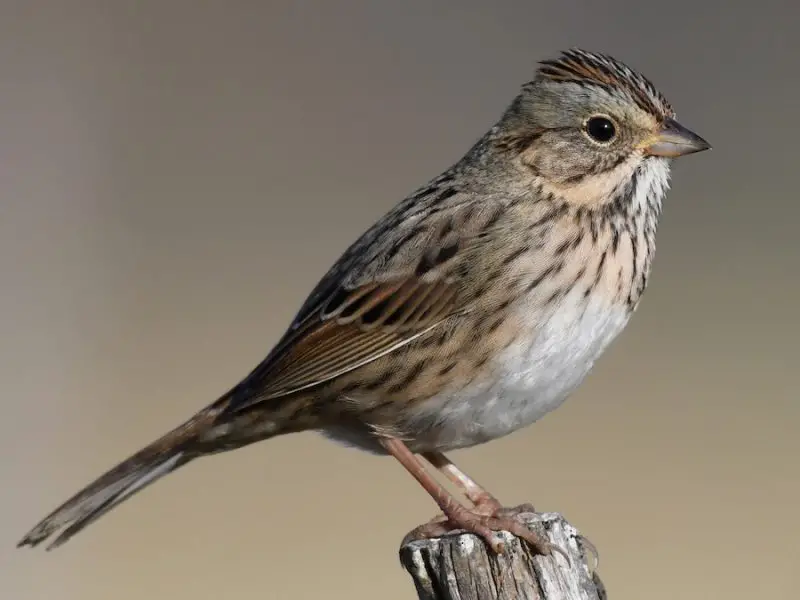
Lincoln’s Sparrow is a shy and attractive sparrow, subtly patterned with fine streaks on its gray chest, buffy facial markings, and a finely streaked crown. It’s slightly smaller than the Song Sparrow, measuring about 5.1 to 5.9 inches in length with a wingspan close to 8.7 inches. Its buffy wash across the breast sets it apart from other similar sparrows.
In Texas, Lincoln’s Sparrows are most commonly seen during migration in spring and fall, but many also remain during the winter, particularly in central and southern areas. They prefer moist, brushy habitats like wet meadows, stream edges, and shrubby fields. They’re typically solitary and elusive, often staying hidden under low cover.
Their soft, trilled song is rarely heard in Texas, since they mostly breed far to the north. Still, careful observers may spot them flitting through the understory or hear their sharp, metallic call note. Lincoln’s Sparrows are well adapted to blending in with their environment, making them a rewarding find for keen birdwatchers.
White-throated Sparrow (Zonotrichia albicollis)
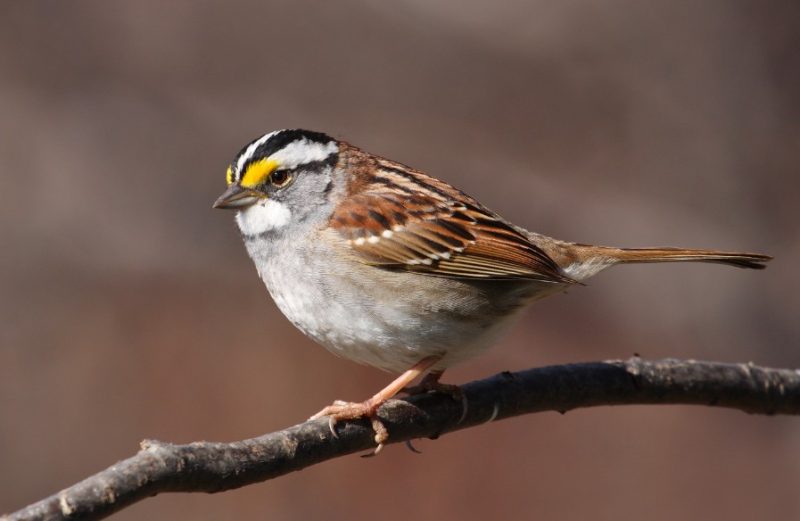
The White-throated Sparrow is a striking bird with a bold white throat patch bordered by dark stripes, and a bright yellow spot between the bill and the eye. There are two color forms: white-striped and tan-striped, both with black-and-white head stripes and grayish bodies. They are larger than many sparrows, measuring around 6.3 to 7.1 inches long with a wingspan of up to 9.1 inches.
In Texas, White-throated Sparrows are winter visitors, seen primarily from late fall through early spring. They frequent wooded edges, thickets, gardens, and brushy areas, where they forage on the ground for seeds and insects. They often scratch through leaf litter with both feet, similar to towhees, and are usually found in loose flocks.
These sparrows are known for their clear, whistled song, often rendered as “Oh-sweet-Canada-Canada,” though they rarely sing in Texas during winter. Their striking appearance and unique behaviors make them a favorite among backyard birders in the eastern and central parts of the state during the cooler months.
White-crowned Sparrow (Zonotrichia leucophrys)
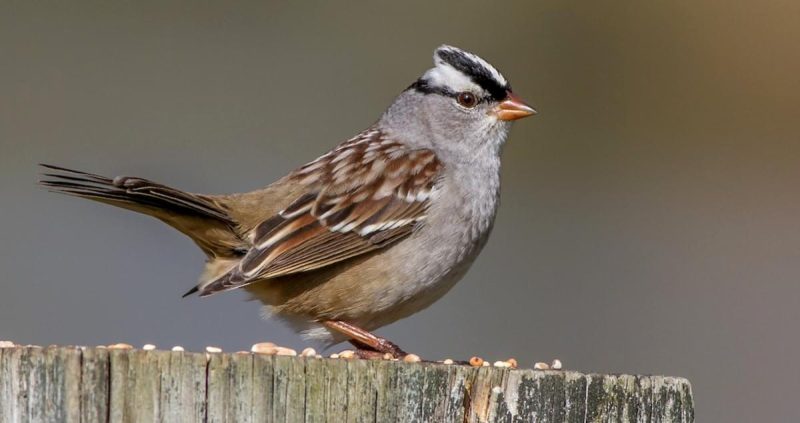
The White-crowned Sparrow is an elegant bird easily recognized by its crisp black and white stripes on the head, pale gray breast, and long tail. It has a plain, clean look compared to other sparrows, with a pink or yellow bill depending on the region. This species measures about 6.3 to 7.1 inches in length with a wingspan of up to 9.4 inches.
In Texas, White-crowned Sparrows are primarily winter residents, arriving in the fall and staying through early spring. They are often seen in open woodlands, hedgerows, weedy fields, desert scrub, and suburban yards, especially in the western and central parts of the state. These sparrows often forage in flocks on the ground, scratching through leaf litter for seeds and insects.
Though their breeding grounds lie far to the north, their sweet, clear whistles can sometimes be heard even in wintering areas. They are not especially shy and may visit backyard feeders offering millet or sunflower seeds. Their distinctive appearance and musical calls make them a favorite among winter birders in Texas.
Harris’s Sparrow (Zonotrichia querula)
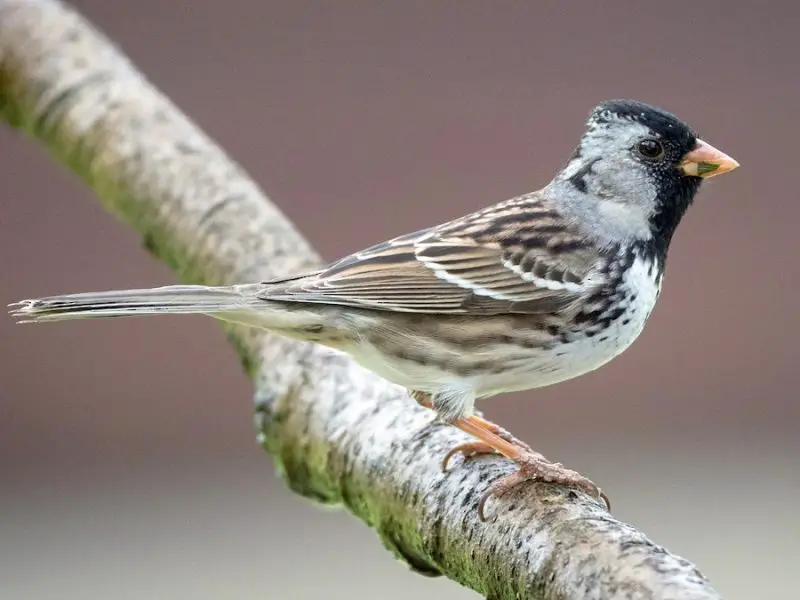
Harris’s Sparrow is the largest sparrow native to North America and is known for its striking black bib, pink bill, and gray face framed by a black crown and throat. Juveniles have a more mottled appearance, but adults are quite distinctive. They typically measure between 6.7 and 7.9 inches long with a wingspan of up to 10.6 inches.
This species winters almost exclusively in the southern Great Plains, and Texas—particularly the northern parts—is one of its main wintering grounds. They favor brushy pastures, open woodlands, hedgerows, and the edges of agricultural fields. These sparrows are often seen foraging on the ground in small flocks, scratching among the leaves for seeds and insects.
Harris’s Sparrows are quiet and shy, often blending into their surroundings. They are rarely found outside their limited winter range, making sightings in northern Texas especially notable. Their slow, whistled songs are more common on the breeding grounds far to the north but may occasionally be heard during mild winter days.
Fox Sparrow (Passerella iliaca)
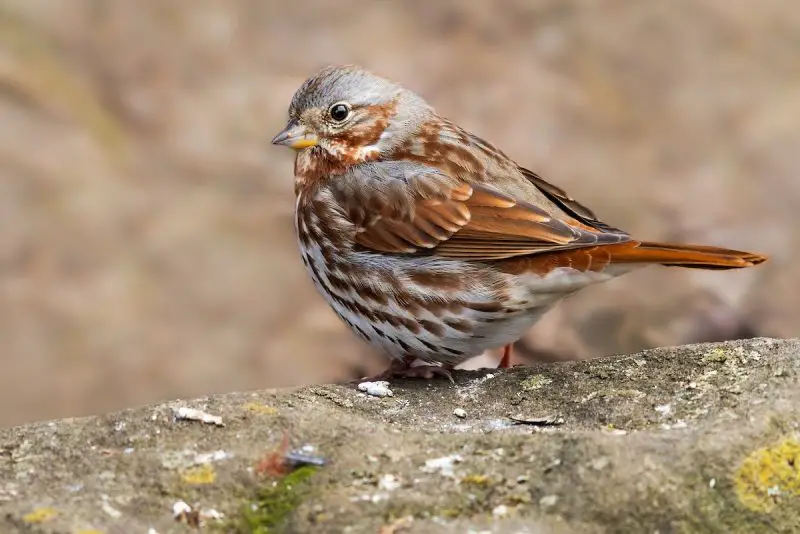
Fox Sparrows are large, chunky sparrows with rich reddish-brown plumage, heavily streaked underparts, and a slightly rounded head. Their streaks often converge into a central spot on the chest. These birds measure about 6.7 to 7.5 inches long with a wingspan around 10.5 inches, making them one of the largest native sparrows in Texas.
In Texas, Fox Sparrows are seen primarily in winter, often in brushy woodlands, forest edges, and thickets along streams or fields. Though they are solitary and shy, they can be observed vigorously scratching through leaf litter with both feet to find seeds, berries, and insects. Their reddish color helps them blend into leaf-covered forest floors.
Though not overly vocal in Texas, their rich, flute-like songs are a highlight on their breeding grounds farther north. Several subspecies exist, and the ones wintering in Texas typically belong to the “Red” group. Birdwatchers in wooded areas of eastern and central Texas often get the best chances to spot this beautiful and elusive visitor.
Swamp Sparrow (Melospiza georgiana)
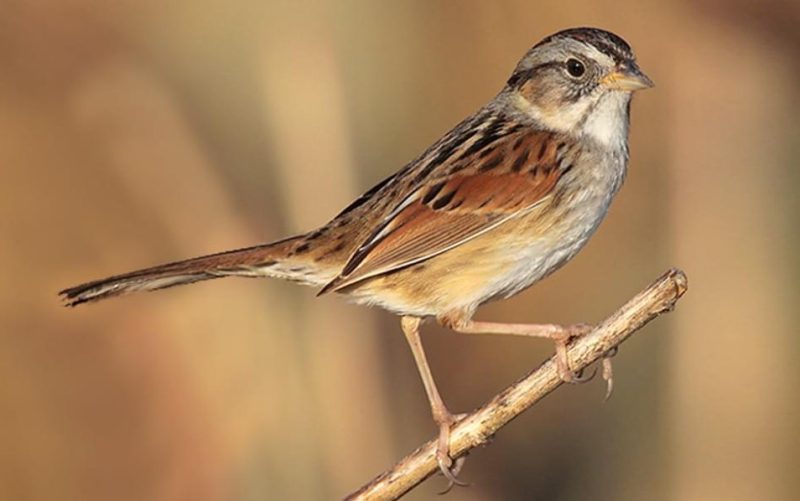
The Swamp Sparrow is a small, secretive bird with a gray face, rusty cap, and reddish wings. Its underparts are grayish with light streaks, and the back is brown with darker markings. Measuring about 4.7 to 5.9 inches in length, it is slightly smaller than many other sparrows, with a wingspan of around 7.1 inches.
As the name suggests, Swamp Sparrows prefer wet, marshy habitats. In Texas, they are winter residents, found mostly in the eastern and coastal parts of the state where swamps, wet meadows, and marsh edges provide suitable cover. These birds are often heard before they are seen, giving a soft “chip” call from within dense vegetation.
They forage low to the ground, usually alone or in small groups, searching for insects and seeds in muddy or damp areas. Though not brightly colored, their subtle plumage and preference for wetlands make them a rewarding find for birders exploring quiet, soggy areas during the colder months.
Chipping Sparrow (Spizella passerina)
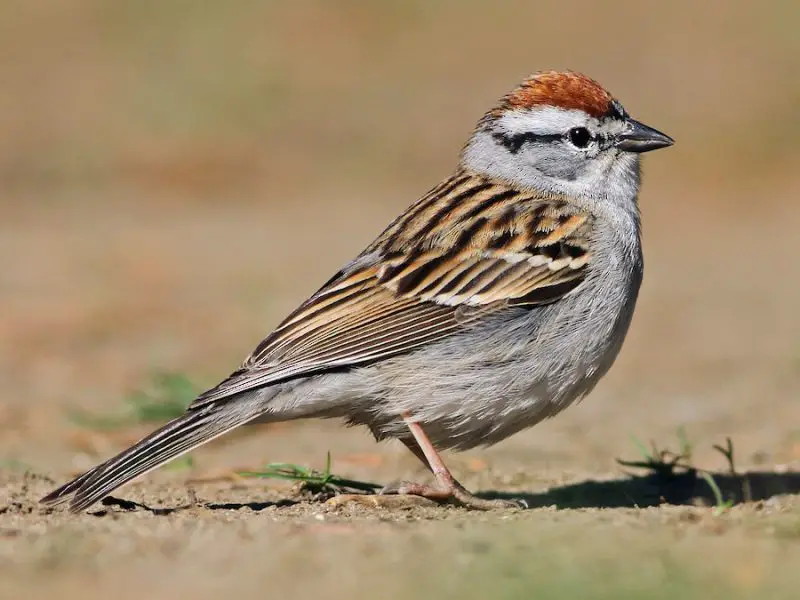
Chipping Sparrows are small, slender birds with a clean gray breast, rusty cap, and distinct black eye line. During the breeding season, adults are especially crisp in appearance, while winter birds appear duller with more streaking. They typically measure 4.7 to 5.9 inches long with a wingspan of about 8.3 inches.
In Texas, Chipping Sparrows are found year-round but are far more common during the winter months when flocks increase dramatically. They inhabit a variety of open spaces, including grassy yards, parks, pine forests, and woodland edges. These sparrows often forage on the ground in flocks, especially near feeders or under trees.
Chipping Sparrows are known for their trilling songs during the breeding season, although wintering birds are usually quieter. In suburban areas, they are comfortable around people and may feed on millet or cracked corn. Their approachable behavior and distinctive markings make them one of the most easily recognized sparrows throughout Texas.
Clay-colored Sparrow (Spizella pallida)
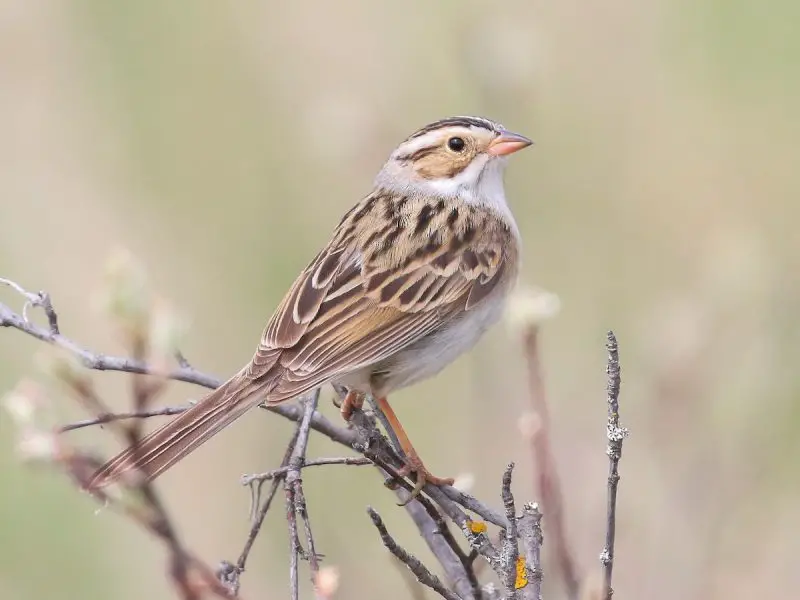
The Clay-colored Sparrow is a small, pale bird with a finely streaked back, clear grayish breast, and a light tan crown marked by a dark central stripe. One of its most distinctive features is the crisp facial pattern, including a pale eyebrow, dark eye line, and gray nape. It measures about 5.1 to 5.9 inches in length, with a wingspan near 8 inches.
In Texas, this species is primarily seen during migration in spring and fall, especially in the central and northern regions. It favors shrubby grasslands, open fields with scattered bushes, and prairie edges. During migration, they often join mixed flocks of sparrows and forage on the ground for seeds and insects.
Though relatively plain in appearance, the Clay-colored Sparrow’s buzzy song—a short, dry trill—can be heard during spring migration. They are typically quiet in fall. Because of their preference for transitional habitats and their tendency to stay low in cover, careful observation is needed to spot this subtly beautiful migrant.
Field Sparrow (Spizella pusilla)
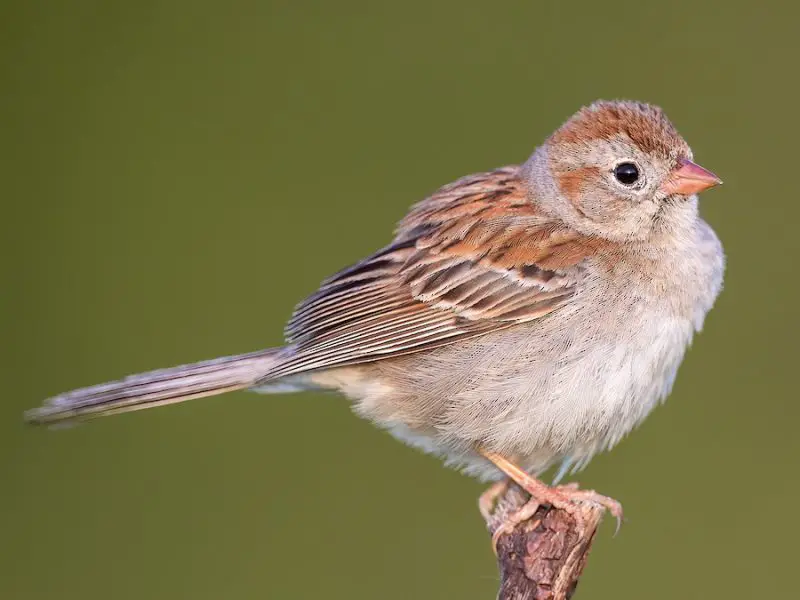
The Field Sparrow is a small, warm-toned bird with a pink bill, plain face, and rufous cap. It lacks strong facial markings, making it look soft and gentle compared to other sparrows. Its underparts are clear and pale, and it measures about 4.7 to 5.9 inches long with a wingspan of approximately 7.9 inches.
In eastern Texas, Field Sparrows are present year-round, using brushy pastures, shrubby woodland edges, and overgrown fields as habitat. They often sing from exposed perches during spring and summer, delivering a sweet, accelerating trill that sounds like a bouncing ball coming to a stop. In winter, they become quieter and gather in small flocks to forage on seeds.
Despite their quiet appearance, Field Sparrows are persistent singers and often among the first to vocalize at dawn during the breeding season. Their populations have declined in some areas due to habitat loss, but they remain locally common in suitable open habitats throughout the eastern part of Texas.
Brewer’s Sparrow (Spizella breweri)
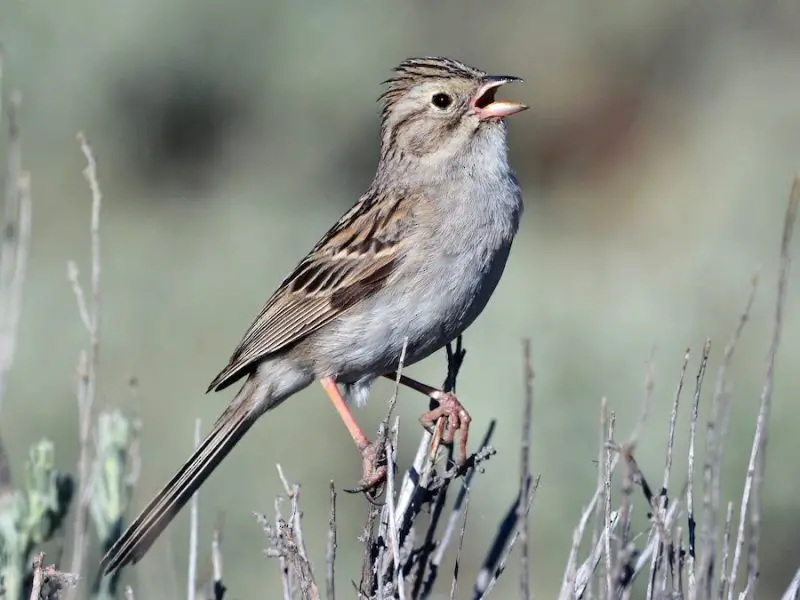
Brewer’s Sparrow is a small, drab bird with a finely streaked back, plain face, and subtle brown and gray tones. It lacks bold markings, which helps it blend into the dry, open landscapes it prefers. It typically measures about 5 inches in length with a wingspan of around 7.5 inches.
In Texas, Brewer’s Sparrows are mostly seen during migration in the spring and fall, especially in the western regions. Some individuals may also overwinter in the far west and southwest of the state. They inhabit arid shrublands, sagebrush flats, and desert edges during their time in Texas, often foraging low among the bushes for seeds and insects.
Because of their inconspicuous plumage and quiet behavior, they can be easy to overlook unless carefully sought out. While they sing a complex, tinkling song on the breeding grounds in the western U.S., they are mostly silent in Texas. Spotting one during migration is a highlight for birders exploring drier habitats in the western part of the state.
Black-throated Sparrow (Amphispiza bilineata)

The Black-throated Sparrow is a striking desert sparrow with a bold black bib, white eyebrow and moustache stripes, and a gray body. Its contrasting face pattern makes it easy to identify, even from a distance. This bird measures around 5.1 to 5.9 inches in length with a wingspan of about 8.3 inches.
In Texas, this species resides year-round in the arid landscapes of the west and south, including desert scrub, rocky canyons, and dry washes. It is especially common in the Trans-Pecos region and parts of the southern border. These sparrows forage mostly on the ground and are often seen hopping between rocks or perching on low shrubs.
The male’s clear, tinkling song is frequently heard during the breeding season, often delivered from a prominent perch. Unlike many sparrows, Black-throated Sparrows are well adapted to desert life, conserving water and feeding efficiently on seeds and small insects. Their bold appearance and beautiful song make them a favorite among birders in the state’s driest regions.
Lark Sparrow (Chondestes grammacus)
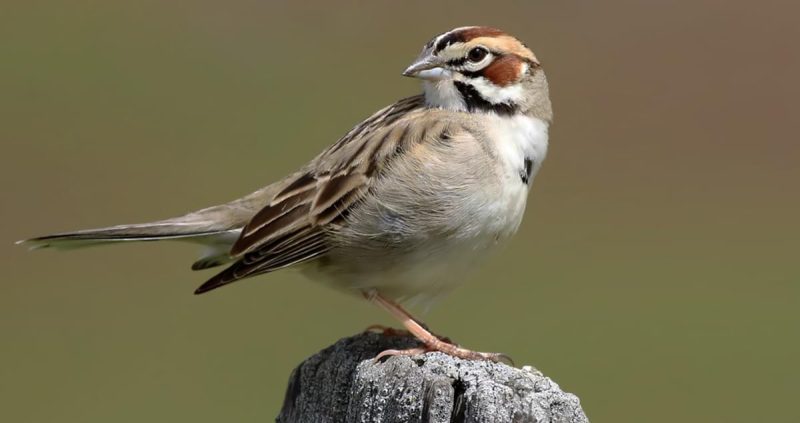
The Lark Sparrow is one of the most distinctive sparrows in Texas, with a boldly marked face, chestnut cheek patch, and black chest spot. Its tail is long and rounded with white outer feathers, which flash when it flies. It is a relatively large sparrow, measuring 6.3 to 6.7 inches in length with a wingspan of up to 11 inches.
In Texas, Lark Sparrows are found statewide and can be seen throughout the year, though they are especially common in spring and summer when they breed. They inhabit grasslands with scattered trees or fences, open fields, and even suburban areas with sparse vegetation. These sparrows forage on the ground and may perch on fences or wires while singing.
Their song is a mix of clear whistles and trills, often delivered from elevated perches. Lark Sparrows are known for their courtship display, which includes tail-spreading and hopping around potential mates. Their bold plumage and distinctive behavior make them easy to recognize across a wide range of open habitats in Texas.
Lark Bunting (Calamospiza melanocorys)
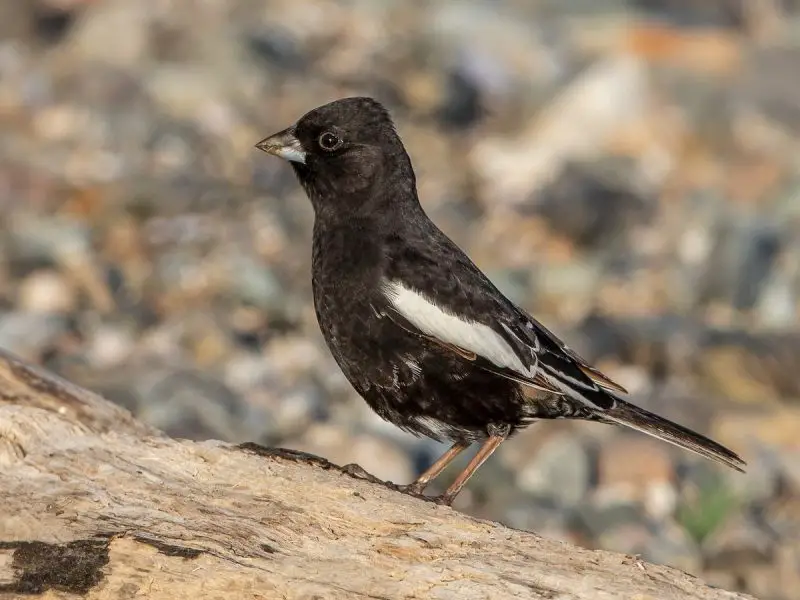
The Lark Bunting is a striking sparrow, especially the breeding male, which features all-black plumage contrasted by bold white wing patches. Females and nonbreeding males are more subdued, with streaky brown bodies and pale underparts. This relatively large sparrow reaches about 5.5 to 7.1 inches in length with a wingspan of up to 11 inches.
In Texas, Lark Buntings are found during the summer in the northern Panhandle, where they breed in grasslands and prairie habitats. During spring and fall, they migrate through other parts of the state, typically in flocks. Their preference for open terrain with scattered shrubs and grasses makes them vulnerable to habitat changes, but they remain locally common in suitable breeding areas.
Males perform an aerial display flight and sing musical warbling songs to attract mates during the breeding season. Outside of breeding, they are more inconspicuous and form ground-feeding flocks. Observing a full black male with white wings gliding over the Texas prairie is a memorable experience for summer birders in the Panhandle.
Grasshopper Sparrow (Ammodramus savannarum)
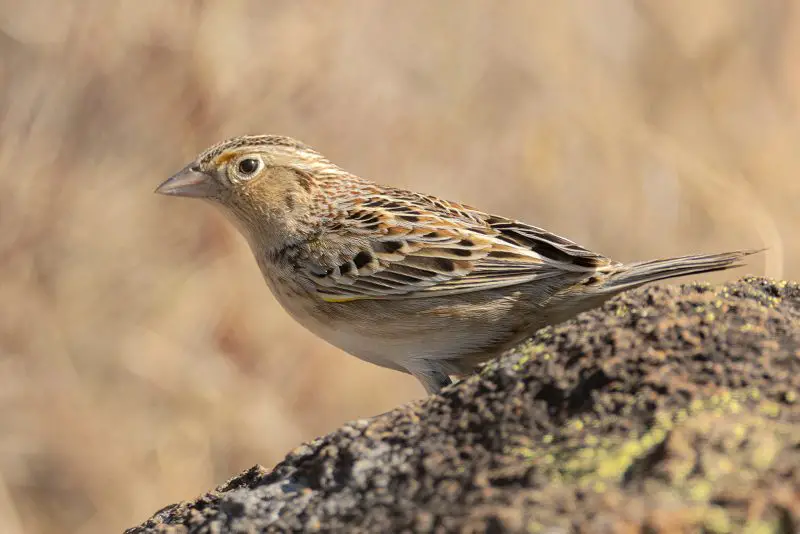
The Grasshopper Sparrow is a small, secretive bird with a flat head, short tail, and a pale, unmarked chest. Its face is buffy with a slight orange tint, and it has a distinct yellow spot near the bend of the wing. This bird measures around 4.3 to 5.1 inches in length, with a wingspan of approximately 8 inches.
In Texas, Grasshopper Sparrows are summer residents, mainly found in native grasslands, prairies, and lightly grazed pastures. They are difficult to spot due to their tendency to remain hidden in tall grasses, often only betraying their presence with a buzzy, insect-like song that resembles a grasshopper’s trill.
Because they spend most of their time low in vegetation and flush only at close range, they are more often heard than seen. Their populations have declined in some regions due to loss of native grassland habitat. Nonetheless, they continue to breed in scattered locations across central and northern Texas during the warmer months.
Bachman’s Sparrow (Peucaea aestivalis)
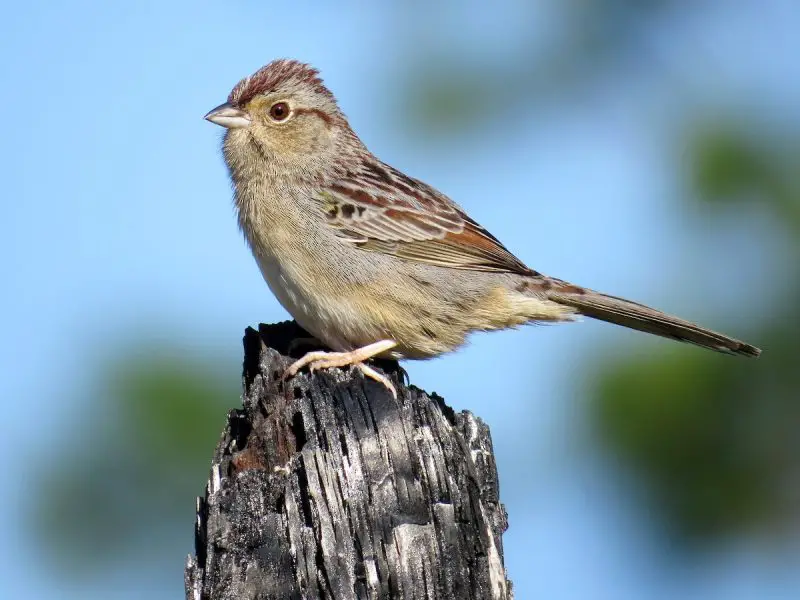
Bachman’s Sparrow is a secretive and chunky sparrow with a rounded tail, warm brown upperparts, and subtle streaking. Its face is grayish with a thin eye ring, and the underparts are buffy and mostly unstreaked. It measures about 5.5 to 6.3 inches in length and is known for its beautiful, clear whistled song.
Historically, Bachman’s Sparrows were found in the pine forests of eastern Texas, but their presence has become increasingly rare. Today, they are considered very uncommon in the state, with only a few scattered breeding records. They inhabit mature pine woodlands with a dense grassy understory, favoring areas maintained by periodic fire.
These birds are highly elusive, staying hidden in low vegetation and typically only revealing themselves when singing from a concealed perch. While they are no longer a regular part of Texas’s birdlife, restoration of pine savannas in the eastern part of the state may one day support their return as breeders.
LeConte’s Sparrow (Ammospiza leconteii)
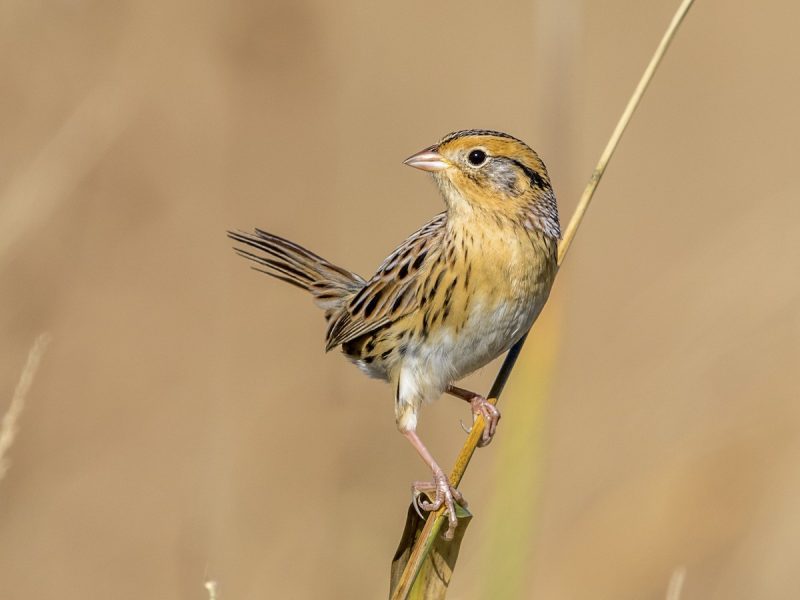
LeConte’s Sparrow is a tiny, beautifully marked bird with a bright orange face, grayish nape, and crisp black streaks on its buffy flanks and back. Its small size—about 4.3 to 5.1 inches long—paired with secretive behavior makes it one of the hardest sparrows to observe in North America.
In Texas, LeConte’s Sparrows are winter visitors, most often found in moist, weedy meadows, overgrown pastures, and grassy wetlands, especially in the eastern and coastal regions. They are ground dwellers, moving through dense grasses and rarely flying unless flushed at close range.
These sparrows are notorious for their stealthy nature. Even when flushed, they quickly drop back into cover, often vanishing from view within seconds. Birders hoping to find them typically focus on gently walking through suitable grassland habitats in winter, often only catching brief glimpses of this elusive species.
Nelson’s Sparrow (Ammospiza nelsoni)
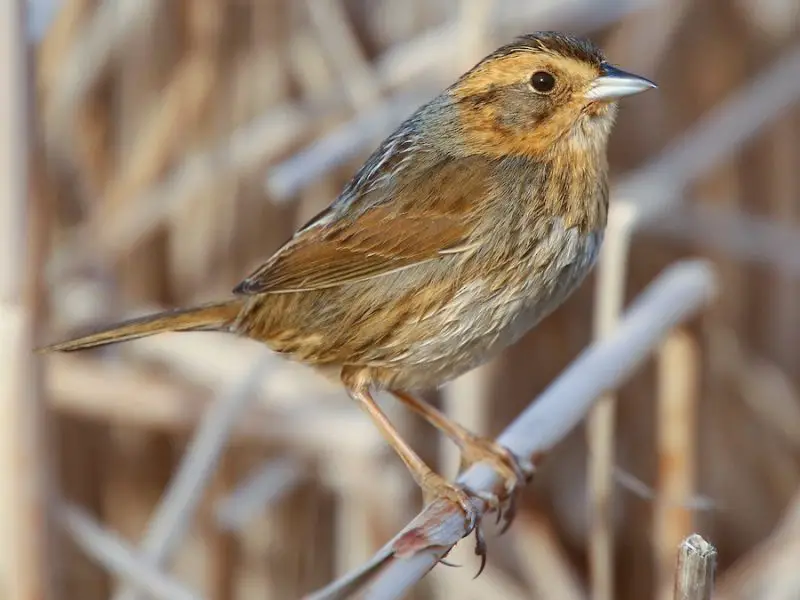
Nelson’s Sparrow is a small and elusive bird with a warm orange face and breast, finely streaked flanks, and a grayish crown with a central stripe. Its soft colors and quiet nature make it difficult to detect. This sparrow measures about 4.3 to 5.1 inches in length with a wingspan near 7 inches.
In Texas, Nelson’s Sparrows are very rare winter visitors, typically found along the Gulf Coast in brackish or saltwater marshes. They inhabit dense, tall grasses in tidal wetlands, where they forage on insects and seeds while staying low to the ground. Their preference for remote and inaccessible habitats contributes to their rarity in the state.
Though rarely seen, Nelson’s Sparrows may occasionally be detected during migration or by experienced birders in specialized coastal environments during the winter months. Their presence highlights the importance of preserving native marsh habitats along Texas’s coast for both resident and migratory birds.
Seaside Sparrow (Ammospiza maritima)
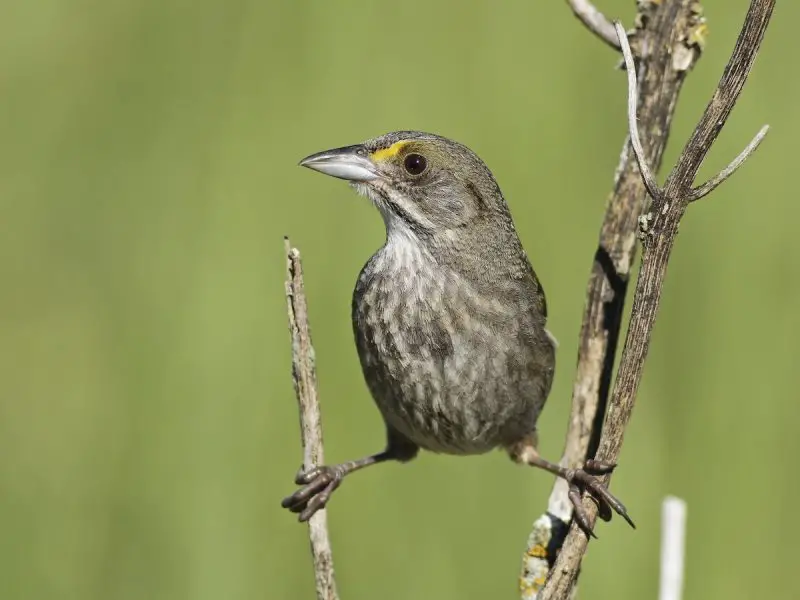
The Seaside Sparrow is a coastal specialist with olive-gray upperparts, a streaked breast, and a subtle yellow wash in front of the eyes. Its thick bill and relatively long tail are useful for navigating dense saltmarsh vegetation. It measures about 5.1 to 5.9 inches in length with a wingspan of around 7.5 inches.
In Texas, the Seaside Sparrow is a rare resident found along the Gulf Coast, particularly in salt and brackish marshes. Although not commonly seen, it is occasionally encountered in the upper coastal marshes where dense grasses like cordgrass provide cover. It forages low to the ground for insects, snails, and seeds, often staying hidden in the vegetation.
Its secretive habits and preference for undisturbed tidal marshes make it difficult to observe. Unlike many sparrows, the Seaside Sparrow is adapted to saline environments and is highly sensitive to habitat degradation. Conservation of coastal marshes is essential to maintain the small Texas populations of this elusive species.
Saltmarsh Sparrow (Ammospiza caudacuta)
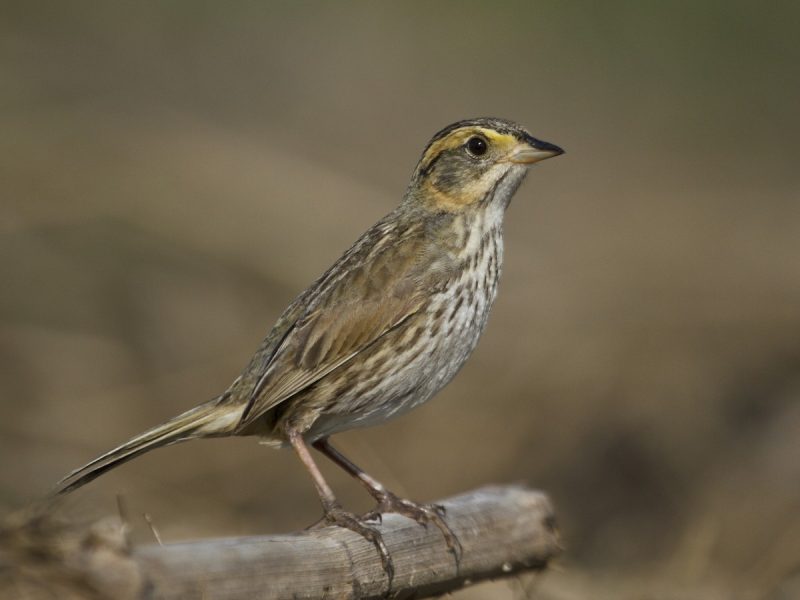
The Saltmarsh Sparrow is a small, finely marked bird with an orange face, gray crown with a dark central stripe, and heavily streaked underparts. Its short tail and delicate plumage are well-suited for a life in coastal marshes. It measures about 4.3 to 5.1 inches long, making it one of the smaller Ammospiza sparrows.
In Texas, the Saltmarsh Sparrow is an extremely rare winter visitor, most likely found in upper Gulf Coast tidal marshes. Its primary range lies farther east along the Atlantic Coast, but a few individuals occasionally wander westward during migration. Even in its core range, it is hard to detect, and in Texas, sightings are exceedingly scarce.
This species is vulnerable to rising sea levels and habitat loss, and it often nests in areas susceptible to flooding. Though unlikely to be seen by most birders in Texas, its presence emphasizes the importance of preserving coastal marshes and monitoring rare winter migrants along the Gulf.
Cassin’s Sparrow (Peucaea cassinii)
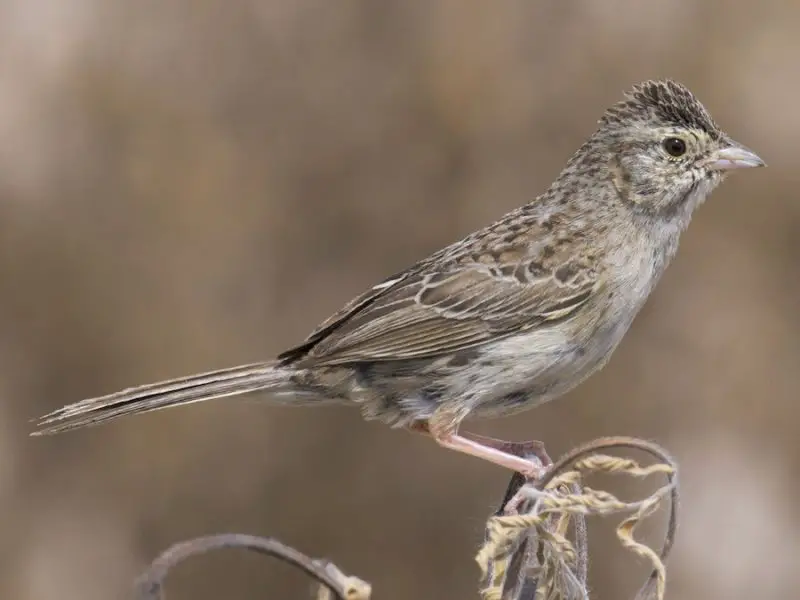
Cassin’s Sparrow is a plain, gray-brown bird with subtle streaking and a long, rounded tail. Though unremarkable in appearance, its large head, pale face, and soft facial pattern help distinguish it from similar species. It typically measures about 5.9 to 6.7 inches in length with a wingspan near 8.3 inches.
This sparrow is a year-round resident of western Texas, where it inhabits arid grasslands, desert scrub, and shrub-steppe regions. It is especially common in the Panhandle, the Edwards Plateau, and the Trans-Pecos. Cassin’s Sparrows often remain quiet and hidden, but during the breeding season, males perform high, fluttering song flights and deliver sweet, musical trills.
Outside of breeding season, they are solitary and inconspicuous, usually feeding quietly on seeds and insects near the ground. Their reliance on native grassland makes them susceptible to habitat changes, but they remain a regular and characteristic species of Texas’s drier landscapes.
Rufous-crowned Sparrow (Aimophila ruficeps)

The Rufous-crowned Sparrow is a handsome bird with a rusty-red crown, gray face, and clean white eye ring. Its body is mostly brownish-gray with fine streaks on the back and faint markings on the breast. It is medium-sized for a sparrow, measuring around 5.8 to 6.3 inches in length.
This species inhabits rocky hillsides, brush-covered slopes, and open woodlands in the mountainous regions of western and central Texas. It is non-migratory and favors areas with sparse vegetation and scattered rocks or boulders. The Edwards Plateau and the Davis and Guadalupe Mountains are among its key habitats.
Rufous-crowned Sparrows are shy but territorial, often singing from exposed perches to mark their space. Their high-pitched, trilling song can be heard in spring and early summer. They forage close to the ground and are rarely seen far from cover, making them a quiet but distinctive resident of Texas’s rugged upland terrain.
Canyon Towhee (Melozone fusca)
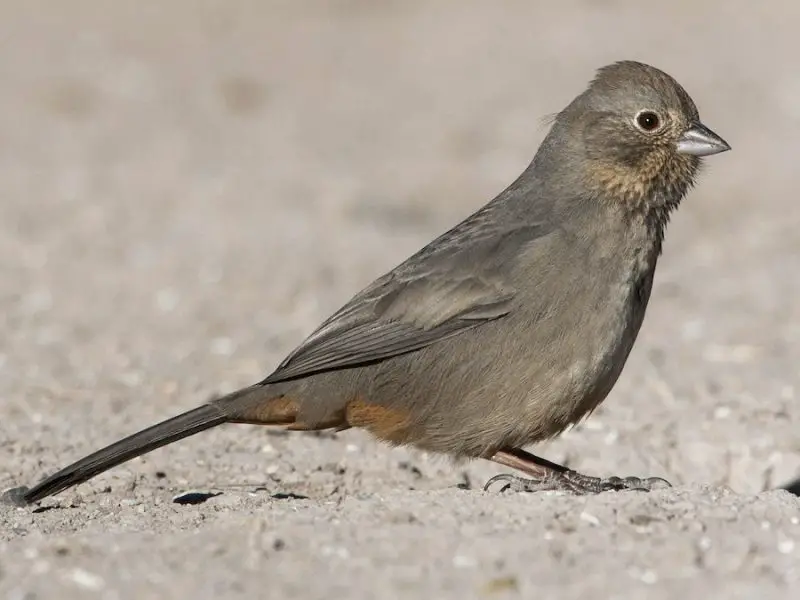
The Canyon Towhee is a large, earthy-toned sparrow-like bird with a dull brown body, long tail, and faint rufous undertones on the underparts. Its head and throat are slightly grayer, and it has a pale eye ring and rusty patch under the tail. It measures around 7.5 to 9.1 inches in length, with a strong and sturdy build.
This species is found year-round in western Texas, especially in desert foothills, rocky canyons, and brushy slopes. It prefers semi-arid regions such as the Trans-Pecos and Big Bend areas, where it is often seen foraging on the ground near shrubs and rocks. Canyon Towhees are often overlooked due to their drab coloration and shy behavior.
They feed mainly on seeds and insects, scratching in the dirt like other towhees. Their soft, chipping calls and clear, sweet whistles are most often heard during early morning or evening hours. Though not flashy, the Canyon Towhee is a reliable and hardy bird of Texas’s rugged western landscapes.
Abert’s Towhee (Melozone aberti)
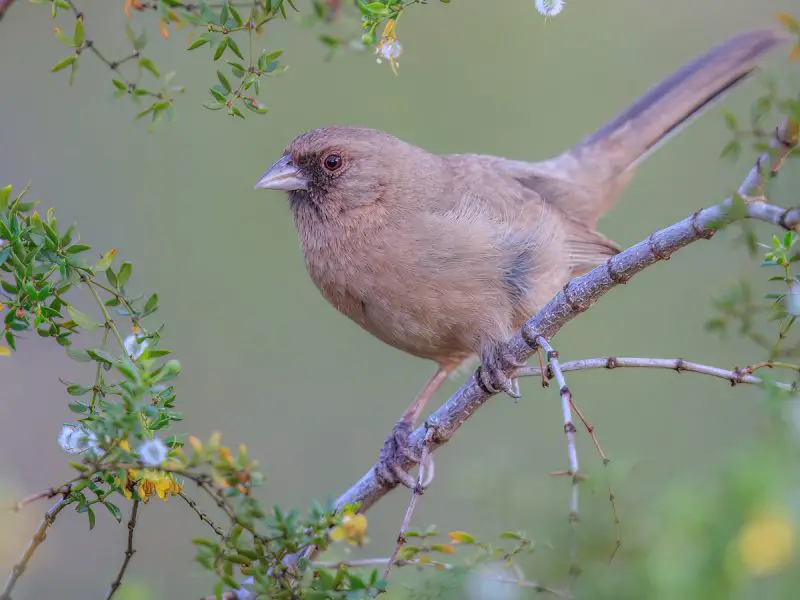
Abert’s Towhee is a large, plain-looking towhee with warm brown plumage, a darker face, and a long, rounded tail. It has a slightly reddish undertone on the flanks and undertail coverts, which are more visible in good light. Measuring about 8.3 to 9.1 inches in length, it is one of the largest towhees and typically stays close to dense ground cover.
In Texas, Abert’s Towhee is extremely rare and mainly found in the far western regions near the Rio Grande, especially around riparian corridors with dense vegetation. It prefers brushy habitats, desert washes, and mesquite thickets, where it can remain concealed while foraging on the ground for seeds and insects.
These towhees are shy and tend to stay low, often hidden under shrubs. Their call is a sharp “chink,” and though they do sing, it is more common in breeding territories outside of Texas. Abert’s Towhee is more common in Arizona and New Mexico, but occasional records in western Texas make it a notable rarity for birders exploring desert riparian zones.
Spotted Towhee (Pipilo maculatus)
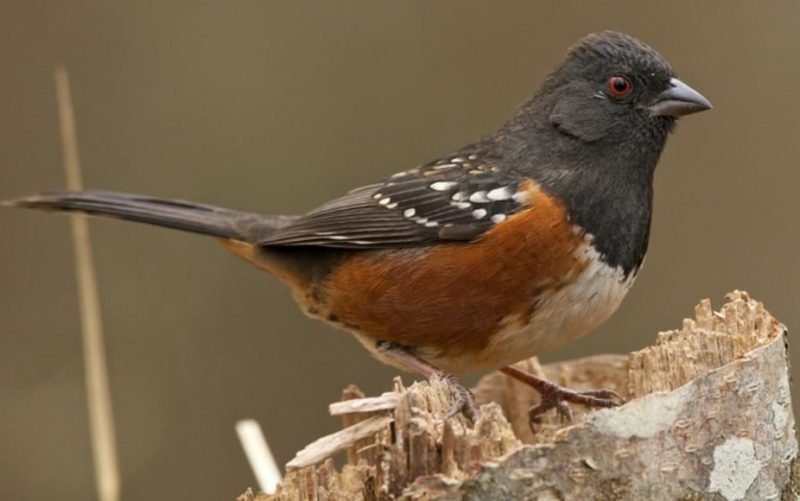
The Spotted Towhee is a striking and large sparrow with a black hood and back (in males), bright rufous sides, and bold white spots on its wings and back. Females are similar but more brownish. They have red eyes, long tails, and strong legs, measuring around 6.7 to 8.3 inches in length with a wingspan up to 11 inches.
In Texas, Spotted Towhees are common in the western part of the state year-round and appear in central regions primarily during the winter. They inhabit scrublands, open woodlands, and brushy canyons, often staying near the ground or hopping among low branches. Their diet includes insects, seeds, and berries, and they use a double-footed scratching motion when foraging.
Their song is a buzzy trill followed by a series of sharp notes, and their call is a loud, rising “chewink.” Though secretive, Spotted Towhees can be quite vocal during the breeding season and are often detected by their call even when hidden in thick cover. They’re one of the more visually distinctive sparrows in Texas’s shrubby habitats.
Eastern Towhee (Pipilo erythrophthalmus)
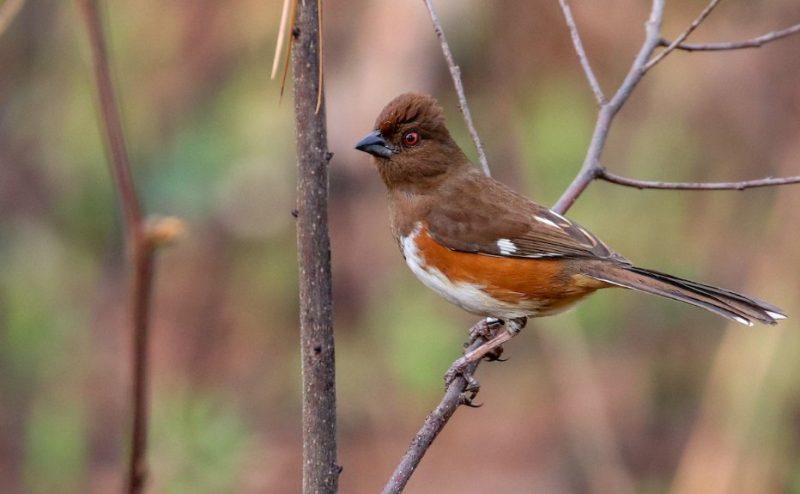
The Eastern Towhee resembles the Spotted Towhee but lacks the white wing spots. Males have jet-black upperparts, a rufous patch on each side, and white bellies, while females display similar patterns in brown tones. These birds are large and robust, measuring about 6.8 to 9.1 inches in length with a wingspan around 10.5 inches.
In Texas, Eastern Towhees are rare and found mostly in the eastern part of the state, especially in brushy forests, thickets, and overgrown clearings. While not commonly seen, they may appear during migration or winter. Their elusive behavior and overlap with the Spotted Towhee make positive identification important in regions where both might occur.
Their well-known call sounds like “drink-your-tea,” and their scratchy foraging style in leaf litter is often heard before they are seen. Although once more widespread, their current presence in Texas is sporadic and mostly limited to suitable wooded habitats in the eastern Pineywoods region.
Olive Sparrow (Arremonops rufivirgatus)
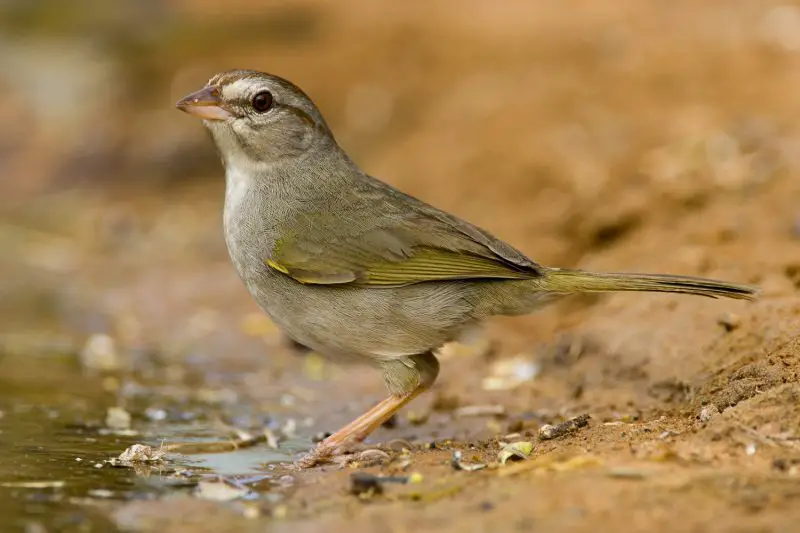
The Olive Sparrow is a small, secretive bird with olive-green upperparts, a gray face, and a chestnut stripe behind the eye. Its underparts are pale and unmarked, and it has a relatively long, rounded tail. It measures around 5.5 to 6.3 inches long, with a compact, sturdy body adapted to life in thick vegetation.
This species is found year-round in southern Texas, especially in the Rio Grande Valley, where it inhabits dense thorn scrub, brushlands, and shaded understory. It forages on or near the ground, moving slowly and staying hidden under cover as it searches for seeds and small invertebrates.
Olive Sparrows are shy and rarely seen in the open, but their accelerating, tinkling song—often described as insect-like—is a helpful clue to their presence. They are non-migratory and unique among Texas sparrows for their subtropical distribution. Their range barely reaches the United States, making south Texas the only place in the country where they can reliably be found.
Green-tailed Towhee (Pipilo chlorurus)
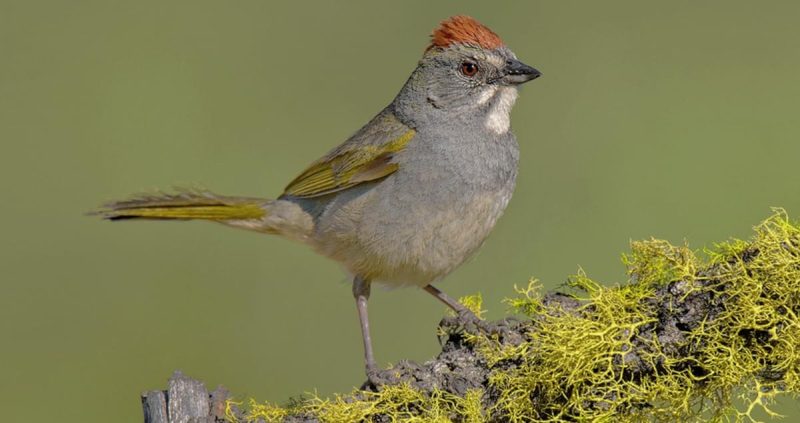
The Green-tailed Towhee is a medium-sized, colorful sparrow with a rufous crown, gray face and chest, olive-green back and wings, and a long greenish tail. This combination of colors makes it one of the most distinctive towhees. It measures about 7.1 to 7.5 inches in length with a wingspan of around 9.4 inches.
In Texas, Green-tailed Towhees are winter visitors to the western regions, especially in the Trans-Pecos and mountainous areas. They prefer arid slopes with scattered brush, desert scrub, and rocky canyons, often keeping low to the ground as they forage among leaf litter and underbrush.
Although shy, they are sometimes seen hopping out into clearings to scratch for food. Their song is a sweet, melodic series of whistles, though they are mostly silent during the winter months in Texas. Their rarity and preference for remote, rugged habitats make them a rewarding find for winter birders exploring the state’s western wildlands.
Baird’s Sparrow (Centronyx bairdii)
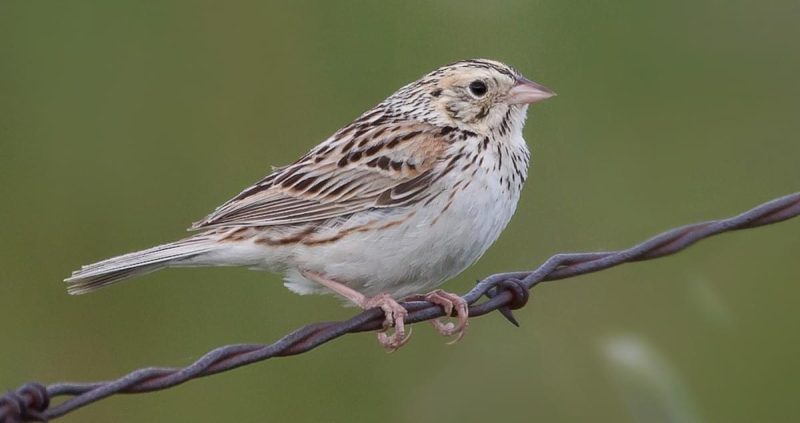
Baird’s Sparrow is a subtly beautiful grassland sparrow with a buffy face, fine streaking on the crown, and a clear, pale breast. It has a slightly flat-headed appearance, a short tail, and a delicate, pointed bill. Measuring around 5 to 5.5 inches in length, it is finely marked and blends in well with dry grassland habitats.
In Texas, Baird’s Sparrows are rare winter visitors primarily found in the Panhandle. They inhabit native prairies, open grasslands, and lightly grazed fields with dense ground cover. Due to their secretive behavior, they are often detected only when flushed or with careful searching through appropriate habitat.
These sparrows feed mostly on seeds and are highly sensitive to habitat changes. Conservation of native grassland in the Panhandle is essential to support their presence. Though they breed far to the north, wintering Baird’s Sparrows in Texas offer a rare opportunity for dedicated birders to observe this declining species.
Vesper Sparrow (Pooecetes gramineus)
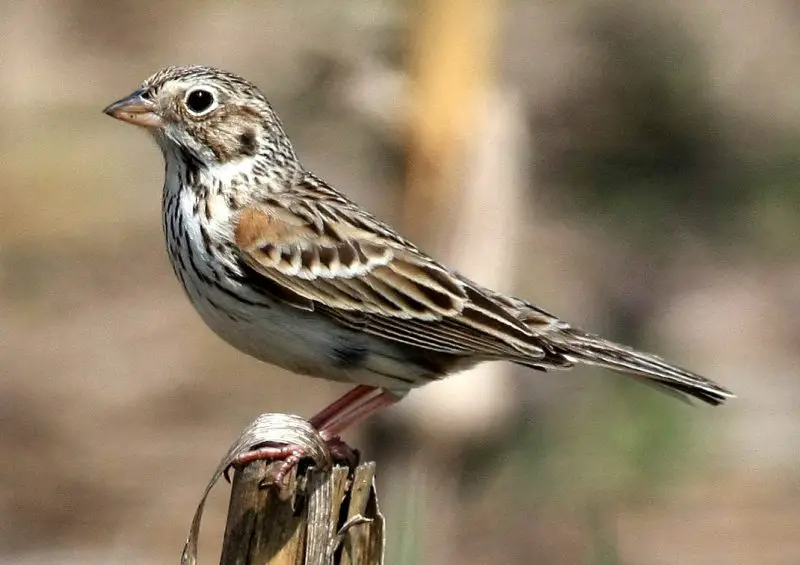
The Vesper Sparrow is a medium-sized, streaky brown bird with a white eye ring, white outer tail feathers, and a subtle rufous patch on the bend of the wing. It has a plain but well-proportioned appearance and measures about 5.9 to 6.3 inches long with a wingspan of roughly 10 inches.
In Texas, Vesper Sparrows are seen during the winter and migration periods, commonly found in open fields, grasslands, pastures, and roadside edges. They often feed on the ground, walking or hopping rather than hopping in quick bursts like some sparrows. When flushed, their white tail edges are easily visible in flight.
They are named for their lovely, melodic song sung during summer evenings on the breeding grounds far north of Texas. In winter, they remain mostly silent and inconspicuous, but their ground-foraging habits and subtle field marks make them an important part of Texas’s winter sparrow flocks.
Dark-eyed Junco (Junco hyemalis)
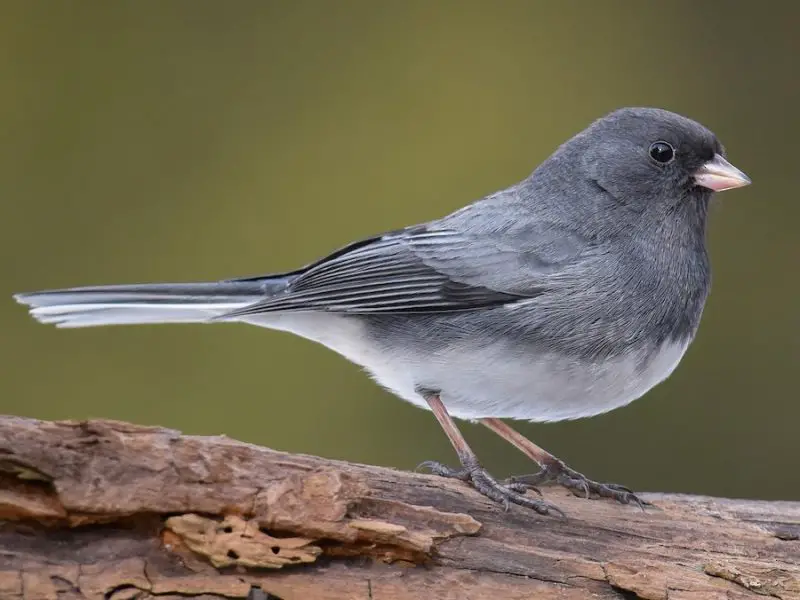
Dark-eyed Juncos are small, round-bodied sparrows with a clean gray or brownish-gray appearance, white belly, and white outer tail feathers that flash in flight. They have a pale pink bill and vary widely in plumage depending on the subspecies—ranging from the “Slate-colored” to “Oregon” types. Their length is about 5.1 to 6.9 inches with a wingspan near 9.8 inches.
These birds are winter regulars across much of Texas, favoring woodlands, brushy fields, gardens, and suburban edges. They often forage in small flocks on the ground, scratching through leaves for seeds and small invertebrates. During colder months, they frequently visit feeders, especially where millet or cracked corn is offered.
Dark-eyed Juncos are familiar and welcome winter visitors, often referred to as “snowbirds” due to their seasonal arrival. Their tinkling calls and sudden bursts of flight with flashing tails make them easy to recognize even in mixed flocks during the cooler months across central and northern Texas.
McCown’s Longspur (Thick-billed Longspur) (Rhynchophanes mccownii)
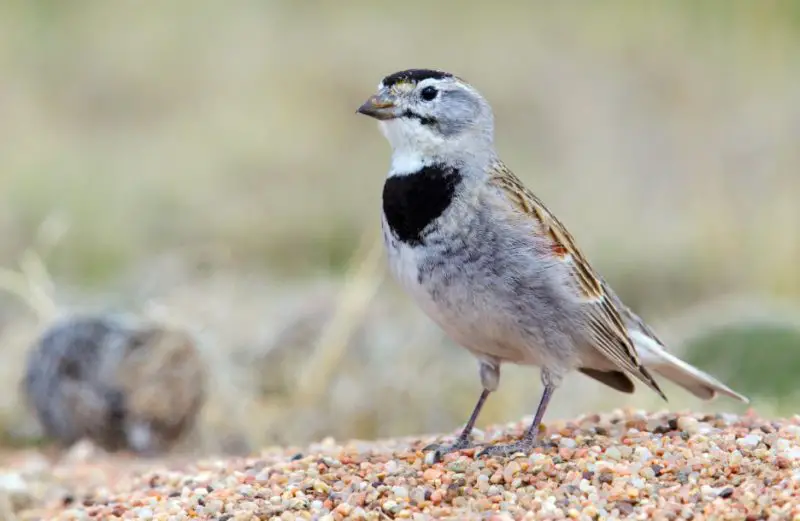
Now known as the Thick-billed Longspur, this bird is a stocky, pale-colored ground-dwelling songbird. In winter plumage, it has a streaked back, buffy underparts, and a large, conical bill. Its breeding plumage is more dramatic, with black and white facial patterns and a rust-colored nape. It measures about 5.9 to 6.3 inches long.
In Texas, Thick-billed Longspurs are winter residents of the open shortgrass prairies and agricultural fields of the Panhandle and western parts of the state. They form loose flocks and forage on the ground for seeds and small invertebrates. Their camouflaged plumage helps them blend into dry, open habitats.
They are quiet and inconspicuous in winter, often walking rather than hopping and taking flight with a soft rattling call. Once widespread, their populations have declined due to habitat changes, but they remain locally common in suitable Panhandle habitats during the winter months.
Chestnut-collared Longspur (Calcarius ornatus)
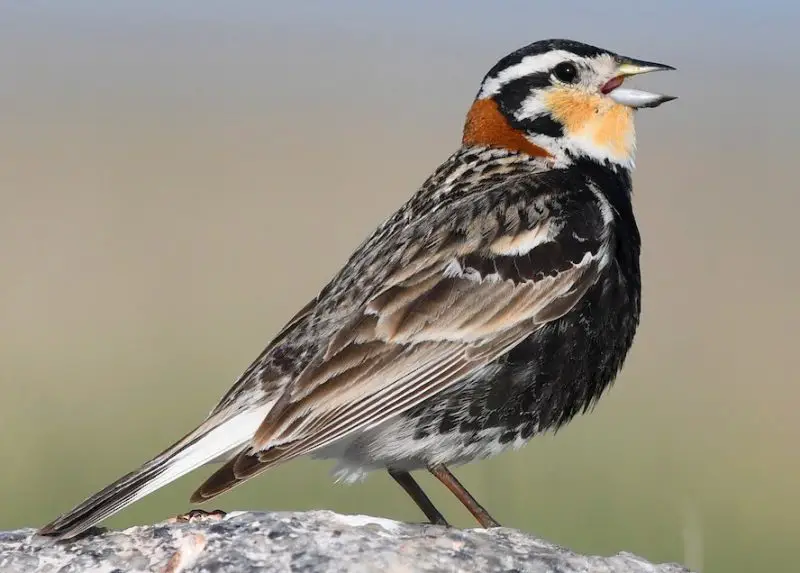
The Chestnut-collared Longspur is a graceful bird with a short tail, rounded body, and in breeding plumage, a rich chestnut collar, black belly, and pale face. In winter, it is much duller and streakier, with a buffy wash and fine facial markings. It measures about 5.1 to 5.9 inches in length with a wingspan of around 10 inches.
In Texas, this species is a regular winter visitor, mainly found in the Panhandle and northwestern regions. It favors shortgrass prairies, overgrazed pastures, and fallow fields where it forms flocks that feed on seeds close to the ground. They are highly ground-oriented, often walking through open spaces and flushing in low, whirling flocks.
Although quiet during winter, Chestnut-collared Longspurs are known for their sweet, tinkling songs in summer. Their presence in Texas’s northern grasslands during the colder months is a testament to the importance of maintaining open, undeveloped spaces for overwintering prairie birds.
Lapland Longspur (Calcarius lapponicus)

Lapland Longspurs are striking arctic songbirds with bold black, chestnut, and white patterns in breeding plumage. In winter, they appear heavily streaked with a buffy face and a dark crown. They are medium-sized longspurs, measuring about 5.9 to 6.3 inches in length with a wingspan around 11 inches.
In Texas, Lapland Longspurs are rare and limited mostly to the Panhandle during winter. They occur in open, barren fields and shortgrass plains, often mixing with other longspur species in large, swirling flocks. Their soft, rattling calls and rapid, low flight distinguish them in motion.
This species breeds far in the Arctic and migrates to the central United States for winter. In Texas, their numbers vary greatly from year to year, making them a special sight for birders venturing into the Panhandle’s wide-open, wind-swept habitats during the coldest months.
American Tree Sparrow (Spizelloides arborea)
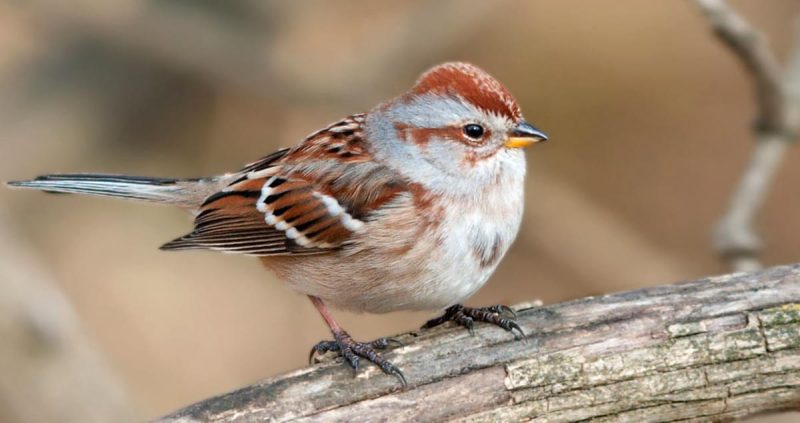
The American Tree Sparrow is a plump, soft-colored sparrow with a rusty cap, gray face, and a small dark central spot on the chest. It has a bicolored bill—dark above and yellow below—which is a helpful field mark. This species measures about 5.5 to 6.3 inches long with a wingspan of approximately 9.5 inches.
In Texas, American Tree Sparrows are extremely rare and mostly restricted to the far northern Panhandle during winter. They prefer weedy fields, shrubby edges, and open woodland margins, often in regions with cold, snowy winters. They forage on seeds and insects near the ground and may associate with other sparrow flocks.
These sparrows breed in the far northern tundra and boreal forests, making their appearance in Texas quite exceptional. Birders hoping to see them in the state must travel north in winter and search carefully in suitable habitats where the species is known to appear during irruptive years.
FAQs About Sparrows in Texas
What types of sparrows can be found in Texas?
Texas hosts a diverse range of sparrows—more than 30 species—ranging from year-round residents like the House Sparrow, Olive Sparrow, and Canyon Towhee, to seasonal visitors such as the White-crowned Sparrow, Savannah Sparrow, and Dark-eyed Junco. Some species are only seen during migration, while others are highly localized or rare.
When is the best time to see sparrows in Texas?
Winter is the best season to see the greatest variety of sparrows in Texas. From November through March, many northern sparrows migrate south to overwinter in the state, especially in the Panhandle, Central Texas, and along the Gulf Coast. Spring and fall migrations are also good times to spot transient species like the Clay-colored Sparrow and Grasshopper Sparrow.
Where should I look for sparrows in Texas?
Sparrows inhabit a variety of environments, depending on the species. Grassland sparrows like the Vesper Sparrow and Baird’s Sparrow favor prairies and open fields. Brush-loving sparrows such as the Olive Sparrow and Rufous-crowned Sparrow prefer dense scrub or rocky slopes. Wetland sparrows, like the Swamp Sparrow and Nelson’s Sparrow, are found in marshes and wet meadows. Parks, suburban yards, and feeders also attract many wintering sparrows.
How can I identify different sparrows in Texas?
Sparrows can be tricky to identify, but key features include head patterns, streaking on the breast or back, tail shape, and habitat. For example, the White-throated Sparrow has a bold white throat and yellow lores, while the Lark Sparrow shows a striking face pattern and white tail corners. Listening for songs and calls is also helpful, especially in the breeding season.
Are all sparrows in Texas native species?
No. While most sparrows in Texas are native, the House Sparrow (Passer domesticus) is an introduced species from Europe. It is now widespread across urban and suburban areas and is not native to North America. In contrast, native species like the Song Sparrow, Field Sparrow, and Spotted Towhee are integral parts of Texas’s natural ecosystems.
Do sparrows visit backyard bird feeders in Texas?
Yes, many sparrows visit feeders, especially in winter. Species such as the White-crowned Sparrow, Chipping Sparrow, Dark-eyed Junco, and House Sparrow commonly feed on millet, cracked corn, and black oil sunflower seeds scattered on the ground or in tray feeders. Providing cover near feeders also encourages shy ground-feeding species to visit.
Are any sparrows in Texas considered rare or threatened?
Yes. Some species, such as Bachman’s Sparrow, Saltmarsh Sparrow, and Lapland Longspur, are rare in Texas due to habitat loss or limited range. Bachman’s Sparrow was once more common in East Texas but is now almost absent. Others, like Baird’s Sparrow, appear irregularly and only in specific regions such as the Panhandle.
How do sparrows contribute to the ecosystem in Texas?
Sparrows play important ecological roles by controlling insect populations, spreading seeds, and serving as prey for predators. Ground-foraging sparrows help break down organic material while feeding. They also serve as indicators of grassland and wetland health, making them valuable to both birders and conservationists.
Can I hear sparrows sing in Texas?
Yes, many sparrows sing beautiful and complex songs, especially during spring and early summer. Species like the Song Sparrow, Field Sparrow, and Cassin’s Sparrow are known for their melodious trills and whistles. Even some winter residents may give quiet contact calls or occasional songs during warm spells.
What is the difference between a towhee and a sparrow in Texas?
Towhees, like the Spotted Towhee, Eastern Towhee, and Canyon Towhee, are part of the larger sparrow family but tend to be larger, more robust, and more ground-oriented. They also have stronger legs for scratching leaf litter. Despite differences in behavior and size, they are still considered sparrows within the family Passerellidae.

